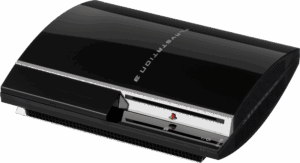
The PlayStation 3 (PS3), released in 2006, was Sony’s third home video game console. A highly ambitious and expensive piece of hardware for its time, it competed against the Xbox 360 and Nintendo Wii in the seventh generation of consoles. The console’s launch was met with mixed reviews due to its high price and complex “Cell Broadband Engine” processor, but it eventually gained commercial success through hardware redesigns, price drops, and a library of critically acclaimed games.
Key innovations and challenges
- Integrated Blu-ray Disc player: The PS3 included a built-in Blu-ray drive, a major feature at launch. It gave Sony a significant advantage over Microsoft’s Xbox 360, which opted for an external HD DVD add-on, and proved instrumental in establishing Blu-ray as the standard for high-definition media.
- The Cell processor: Developed by Sony, Toshiba, and IBM, the PS3’s powerful but notoriously difficult-to-program Cell processor initially hampered developers’ efforts to get the most out of the system. Over time, developers began to master its architecture, leading to some of the console’s most impressive titles.
- High launch price: When the PS3 launched in North America, the 60GB model cost $599. This was a major point of criticism that put off many consumers and contributed to early sales struggles. It also meant Sony sold the console at a significant loss for several years.
- PlayStation Network (PSN): The PSN was Sony’s first major unified online service, allowing users to play online, browse the PlayStation Store, and communicate with friends. Unlike Microsoft’s Xbox Live, the core features of PSN were free, with a paid PlayStation Plus service launching later.
- “Sixaxis” and DualShock 3 controllers: The PS3 launched with the wireless Sixaxis controller, which introduced motion-sensing technology similar to the Wii but controversially omitted vibration. The following year, Sony released the DualShock 3, which added rumble feedback alongside motion controls.
- OtherOS: Early “fat” PS3 models famously included the ability to install a Linux operating system, allowing enthusiasts and researchers to use the powerful Cell processor for non-gaming applications like supercomputing. Sony removed this feature in a 2010 firmware update, citing security concerns.
Hardware revisions
Throughout its lifespan, Sony introduced several hardware revisions to cut costs and improve performance.
- Original “Fat” model: The initial release was bulky and expensive, but the high-end 60GB version offered hardware-based backward compatibility with most PlayStation 2 games, a feature removed in later revisions.
- “Slim” model (2009): This revision was 33% smaller, 36% lighter, and more energy-efficient. It removed the PS2 hardware backward compatibility but made the system more affordable and appealing to a wider audience, helping Sony close the sales gap with the Xbox 360.
- “Super Slim” model (2012): This final revision was even smaller and lighter and replaced the slot-loading Blu-ray drive with a cost-saving, top-loading one.
Notable exclusive games
The PS3 cemented its comeback with a powerful lineup of exclusives that took full advantage of the console’s power.
- The Last of Us: A landmark action-adventure game with a powerful, emotional narrative.
- Uncharted series: The Uncharted series launched on PS3, following the adventures of explorer Nathan Drake.
- God of War III: A highly acclaimed action game that pushed the console’s graphical capabilities.
- Metal Gear Solid 4: Guns of the Patriots: An epic cinematic action game and a PS3 exclusive.
- LittleBigPlanet: A charming platformer that gave players powerful tools to create and share their own levels.